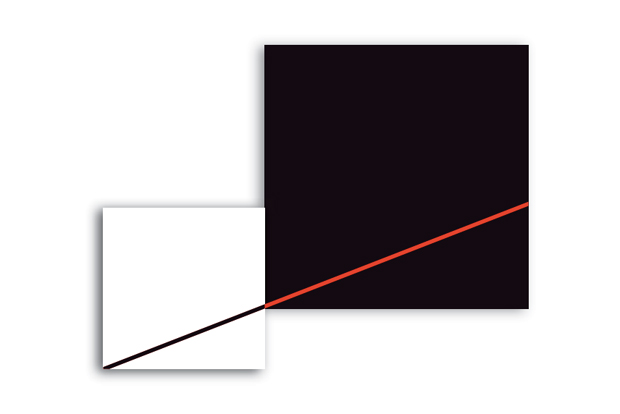
The beauty of the golden ratio
Artist Jo Niemeyer's obsession with the magic number 1.61803399, that's influenced art for thousands of years
Like many artists, architects and designers before him, German artist and designer Jo Niemeyer has a fascination with the mathematical notion of the ‘golden ratio’ (sometimes called the golden section). His work incorporates its rules of absolute precision. The number 1.61803399, which represents this ratio, has influenced design, architecture and art for thousands of years. Indeed, the results are often aesthetically pleasing visualisations of three and two dimensional creations – including the pyramids, which are thought to have been constructed using it, and the work of Leonardo da Vinci who used it, among other things, to most stunning effect.

Jo Niemeyer, Untitled (2000), acrylic on canvas on wood, 209 x 209cm
These laws of mathematics are evident throughout all areas of nature. As Galileo most succinctly penned, “The universe is written in the language of mathematics, and its characters are triangles, circles and other geometric figures.” It's this dialogue between precision and beauty in nature that first compelled the German-born artist to capture these complexities – albeit in a most simplistic and reductionist manner.
Niemeyer was surrounded by artistic influence early on in life, with both of his parents enveloped within creative worlds: his father adopted the concrete method in the medium of paint and his mother designed textiles. Niemeyer began his artistic journey himself after spending large amounts of time in the mountains, where he became fascinated by his surroundings. He began to study the snow, clouds and mountainous landscapes to explore the possibilities of structure, space, distance and proportion. After primarily exploring these themes through photography, Niemeyer then began to work with paint to express the intrinsic possibilities of the natural world.

Jo Niemeyer, Untitled 151 (1991), acrylic on canvas on wood, 80 x 80cm
The basis of his work as an artist is the connection between art and nature, between the artistic action and the experimental work. "On the one hand my work is based on events in nature and civilisation as well as on communication with colleagues of other disciplines," he says. "The dual pole nature - art is for me not only the basis of my experience but at the time also my central theme. My main interest is directed to the perception of space, time, distances and proportion and forms the synthesis between art and nature which implies in the end a dialogue between man and nature."
Although perhaps unobvious to those in the dark about such inherent mathematical connections to the natural world, Niemeyer’s work holds a rigid beauty of its own, in the accurate lines, the definite nature of the prominent shapes and the meticulous working of positioning and proportion. The paintings serve as a back to basics course of appreciation for the contours in a leaf shape, the intricate geometric structure of a snowflake or the delicate curl of a Fibonacci spiral.
For the mathematically untrained, it is his ability to create a compositionally intuitive painting, one where sense, definiteness and form meet in a perfectly neat yet stark canvas that appeals. The Mondrian-esque primary colours scream simplicity, a raw, stripped-back form of nature in its purest and most reduced form. It is an alternative way of looking at environmental composition, one which moves away from the easy, yet reflective click of a photograph, but this does not mean it is any less relevant, in fact, we could say that Niemeyer presents nature in its purest form, something that can be mathematically binding, yet accessible to all.

Jo Niemeyer, Punikki 8, acrylic on canvas on wood, 80 x 80cm
His 20 steps around the globe is a land-art project comprising 20 stainless-steel pillars implanted at precisely computed locations in different countries on various continents. Naturally, the exact locations are decided upon using the golden ratio rule. The location of the points is achieved by using computer and satellite navigation. "It's not the point to see more or less but to peceive the world in a new and different way," he says. ’20 steps around the globe…’ means a mythological journey which is two things: an adventure and an interdisciplinary expedition into no-man’s land between the borders of science, philosophy and religion. Last but not least it is this principle of crossing the boarders which holds the experimental charm of this project."
The golden ratio was prevalent in renaissance art. Both Leonardo da Vinci and Michelangelo were intently interested in mathematical equations and naturally occurring proportions. You can dig deeper into these roots of the golden ratio in this great Phaidon book. And, if you have a moment, let us know what you think about Niemeyer's work in the comments box below.